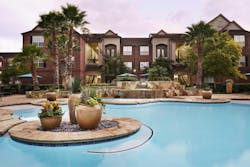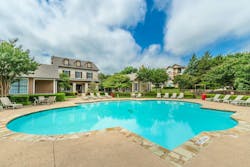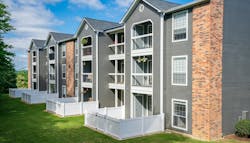Even as home prices surge, the American dream of homeownership endures. “It’s not that people don’t want their own house, it’s that they can’t pay for it,” says Mitchell Rotta, senior managing director, TruAmerica MultiFamily.
In 2021, the median existing-home sales price was $346,900—an increase of $50,200 over the previous year, according to the National Association of Realtors. That was a jump of 16.9% in one year’s time.
“We need to provide a product that gives people what they’re looking for at the price points they can afford,” Rotta says.
TruAmerica believes that product is build-for-rent (BFR) homes.
TRUAMERICA ACQUIRES THE LOT
Recently, TruAmerica, a Los Angeles-based investor and operator of multifamily developments, launched a new BFR development division. Its first BFR projects will be located in the suburban markets of the Southwest, Southeast, and Texas—or “the smile of the US,” Rotta says. Those markets represent about 60% of the firm’s $16.1 billion portfolio.
BFR appeals to individuals who want the single-family home experience—but without the costs and headaches that come with ownership. As such, TruAmerica’s new BFR focus dovetails with its history of providing multifamily housing to blue-collar and gray-collar workers, Rotta explains.
It also aligns with a larger trend. BFR is now the fastest-growing sector of the US housing market. The number of BFR homes increased 30% from 2019 to 2020, and they now account for 6% of new homes built in the US. In January, BFR investments exceeded $50 billion—up from $30 billion just three months earlier, according to John Burns Real Estate Consulting.
As the investor, TruAmerica will partner with third-party builders and contractors. It plans to start construction on its first handful of BFR communities by the end of the year. To appeal to a broad range of consumers, the units will run the gamut from townhomes to detached single-family homes to TruAmerica’s bailiwick: multifamily.
Some of its BFR developments will include both for-rent and for-sale homes. For TruAmerica, that mix of offerings would follow people’s life journeys: first, rent here; later, buy in the same community. “That allows us to create a mini master plan of products that cater to everyone,” Rotta says.
For now, TruAmerica is acquiring land parcels in states including Florida, North Carolina, and Texas. Land acquisition, Rotta says, involves “the biggest struggle” for BFR developments: managing the concerns of municipalities and residents. “It’s a new product segment, even though everything about it looks the same,” he says. People get concerned that this “new” product could introduce new problems.
PROBLEMS WITH THE PROCESS?
Rotta addresses that through direct engagement. He educates communities on TruAmerica’s BFR projects and their objective: bringing more attainable housing to the marketplace. “Once you do that, you find more friends than enemies,” he says.
“Building a house isn’t all that difficult, but bringing the whole process together is,” says Rotta, who brings a diverse array of construction management experiences ranging from high-end custom homes to airport terminals.
The other main BFR challenge, as Rotta sees it, is one that any developer and builder working today knows all too well: high and uncertain construction costs. Mitigating that ongoing struggle involves “being diligent upfront on predicting costs and working with builder partners to have good, efficient designs.”
To get those designs as efficient as they need to be, BFR should serve as a “gigantic runway for alternative building products,” Rotta says. Those can include panel systems, modular construction, and 3D printing—advances beyond traditional stick-frame construction.
“The industry in single-family homes, for the most part, has been a slow adapter of different technologies,” he says. “But we’re in a critical moment where labor pools are shrinking and the costs of traditional materials are increasing. The writing is on the wall for the homebuilding industry: We need to start doing things better.”


